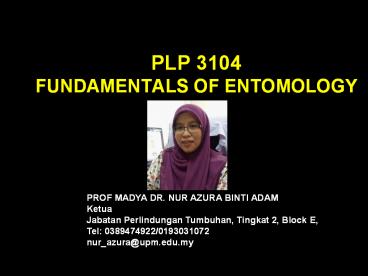PLP 3104 FUNDAMENTALS OF ENTOMOLOGY - PowerPoint PPT Presentation
1 / 25
Title:
PLP 3104 FUNDAMENTALS OF ENTOMOLOGY
Description:
PLP 3104 FUNDAMENTALS OF ENTOMOLOGY PROF MADYA DR. NUR AZURA BINTI ADAM Ketua Jabatan Perlindungan Tumbuhan, Tingkat 2, Block E, Tel: 0389474922/0193031072 – PowerPoint PPT presentation
Number of Views:730
Avg rating:3.0/5.0
Title: PLP 3104 FUNDAMENTALS OF ENTOMOLOGY
1
PLP 3104FUNDAMENTALS OF ENTOMOLOGY
PROF MADYA DR. NUR AZURA BINTI ADAM Ketua Jabatan
Perlindungan Tumbuhan, Tingkat 2, Block E, Tel
0389474922/0193031072 nur_azura_at_upm.edu.my
2
TEST YOUR KNOWLEDGE ON INSECT
- Miilipede/gonggok is an insect. T/F
- Insect can smell. T/F
- All insects can fly. T/F
- Which one is an insect?
B
A
3
TEST YOUR KNOWLEDGE ON INSECT
- 5. Name one type of insects legs
- 6. What does it mean by crepuscular insect?
- 7. Insects have 3-5 pairs of legs. T/F
- 8. Does insect has bone? Y/N
- 9. Legs of an insect is located on the abdomen.
T/F - 10. What is spermatheca?
4
INSECT OVERVIEW THE ENVIRONMENT
- General view of insects
- Why insects is successful
- The importance of insects
- Examples
5
WHY STUDY INSECTS??
6
- ESTIMATION 2 MILL. ANIMAL SPECIES
- gt70 ARE INSECTS SPECIES
7
Why so successful?
- 1) Exoskeleton
- Outside of the body unlike vertebrate
- Gives shape support to soft tissues
- protection from attack or injury
- minimizes the loss of body fluids in both arid
and freshwater environments (has wax) - assures mechanical advantage to muscles for
strength and agility in movement.
8
Why so successful?
- 2) small size
33 cm stick insect
- Fairyflies (Hymenoptera Mymaridae)
- no more than 0.139 mm in length.
goliath beetle 100 g
9
Why so successful?
- Being small, exoskeleton also small
- Being big, exosk. must be big HEAVY!!!!!
10
- minimal resources needed for survival and
reproduction
mealybugs
Leafminer
11
- Easy to hide from predator
- hide in the cracks of a rock, beneath the bark of
a tree, behind the petal of a flower
12
Mole cricket
13
- 3) Flight
- the only invertebrate that can fly
- highly effective mode of escape from predators
- efficient means of transportation, allowing
populations to expand more quickly into new
habitats
14
- The migratory locust,
- Schistocerca gregaria,
- can fly for up to 9 hours
- without stopping
15
- 4) reproductive potential
- Produce large number of eggs
- High fertility (most eggs hatch)
- Short life cycle
- Female have spermatheca for sperm storage
- Asexual reproduction (aphids,thrips,scale
insects males are absent)
16
- 5) metamorphosis
- 86 insect species undergo complete metamorphosis
- immatures and adults (imago) may consume
different types of food, exploit different
environmental resources, and even occupy
different habitats. - Eg butterfly larva consumes leaves, adult
comsumes nectar
17
- 6) adaptation of appendages
- Various type of mouth(piercing, sucking,chewing)
- Consume various type of food
18
THE IMPORTANCE
- 1) PEST of crops/food/other products a
- 2) VECTORS of diseases
- i) Malaria (Anopheles spp., female)- protozoa
Plasmodium falciparum
19
- ii) Dengue Aedes aegypti
- Virus Flavivirus
- Chikungunya Aedes sp.
20
- iii) Enteric diseases (Bacterial and viral
infections of the gastrointestinal tract) - Eg Cholera, Typhoid Fever
- Usually by housefly fecal contamination of food
and water - iv) Sleeping sickness (Africa)
- A bite from Tsetse fly protozoa Trypanosoma
brucei
21
(No Transcript)
22
- 3) POLLINATOR for plants
Halictid bee
Honey bee
23
- 4) Food source for animals/human
- 5) Decomposers (dung beetle, flies etc.)
24
- 6) Bioindicator of stream health
- Dragonfly spp
- 7) Biotic indicator for Forensic Entomology
- Some flies, spp. colonizing human corpse
- 8) Production
- Honey Wax (Apis mellifera)
- Silk (silkworm (Bombyx mori)
- Cochneal (red dye) (Scale insect)
- Shellac (Scale insect)
25
- 9) Medical purposes
- Maggots (Diabetic patient)"blow flies
(Calliphoridae) - Anticoagulant (Black flies) keep laboratory
blood specimens from clotting































